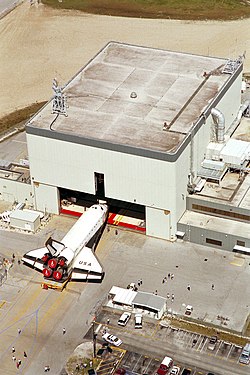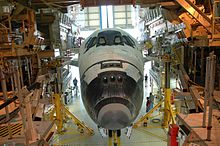Orbiter Processing Facility
| Orbiter Processing Facility | |
|---|---|
| Part of Launch Complex 39 | |
| United States | |
 Space Shuttle Columbia at the entrance of Orbiter Processing Facility 3 | |
| Coordinates | 28°35′09″N 80°39′18″W / 28.585803°N 80.654991°W |
| Type | Facility |
| Height | 29 m (95 ft) |
| Length | 121 m (397 ft) |
| Site information | |
| Operator | |
| Website | http://science.ksc.nasa.gov/facilities/opf.html |
Orbiter Processing Facility (OPF) is a class of
OPF-3 was previously called the Orbiter Maintenance & Refurbishment Facility (OMRF), but was upgraded[when?] to a fully functioning OPF.
Processing flow

When a Shuttle mission was completed, the orbiter was towed from the
- The orbiter's main engines were purged to remove the moisture that was a by-product of liquid oxygen and liquid hydrogen combustion.
- payload bay doors were opened and any hazardous payloads were processed for safety
- fuel cell tanks were drained of remaining cryogenic reactants. The oxygen system was rendered inert with gaseous nitrogen and the hydrogen system with gaseous helium.
- high-pressure gases were vented from the environmental control and life support systems.
- refuse and other waste products including draining of the potable water system were offloaded
- heat shields were removed from the engines and aft access were opened
- main engines were locked in place and covers installed.
- scaffolding was installed around the orbiters aft to allow technicians to access the main engines
- main engines were removed and transferred to the Main Engine Processing Facility for checkout and service
- any needed repairs on the orbiter's thermal protection system including the thermal blankets and thousands of tiles were completed.[2]
- the Reaction Control System pods were possibly removed and transferred to the Hypergol Maintenance Facilityfor troubleshooting, repair or other services.
- any modifications to the orbiter were completed in the OPF.
- After all its flights, the orbiter went through "Down Mission Processing."
Prior to rollout to the Vehicle Assembly Building, several weeks before scheduled launch, the orbiter was prepared for the next mission by installing mission flight kits, payloads, consumable fluids and gases where possible. Remaining payloads, fuels and fluids were installed on the pad closer to launch day. The last step before rollover to the VAB was weighing the orbiter to determine its center of gravity.[1]
Current status
OPF-1 was closed following Atlantis's rollout on June 29, 2012. OPF-2 is now inactive following Atlantis's departure on October 18, 2012. OPF-3 is under lease to Boeing for the manufacture and testing of their
On 8 October 2014, NASA confirmed that
References
![]() This article incorporates public domain material from websites or documents of the
This article incorporates public domain material from websites or documents of the
- ^ a b "From Landing to Launch Orbiter Processing" (PDF). NASA Public Affairs Office. Archived from the original (PDF) on 2011-07-21.
- ^ "Reliable Shuttle Orbiters Need Special Care". United Space Alliance. Archived from the original on 2011-05-22.
- ^ "Boeing to Build Private Space Taxis in Old NASA Shuttle Hangar". Space.com. 2011-10-31. Archived from the original on 2023-06-27.
- ^ a b Dean, James (8 October 2014). "NASA: Secret X-37B space plane will use shuttle hangars". Florida Today. Retrieved 9 October 2014.

